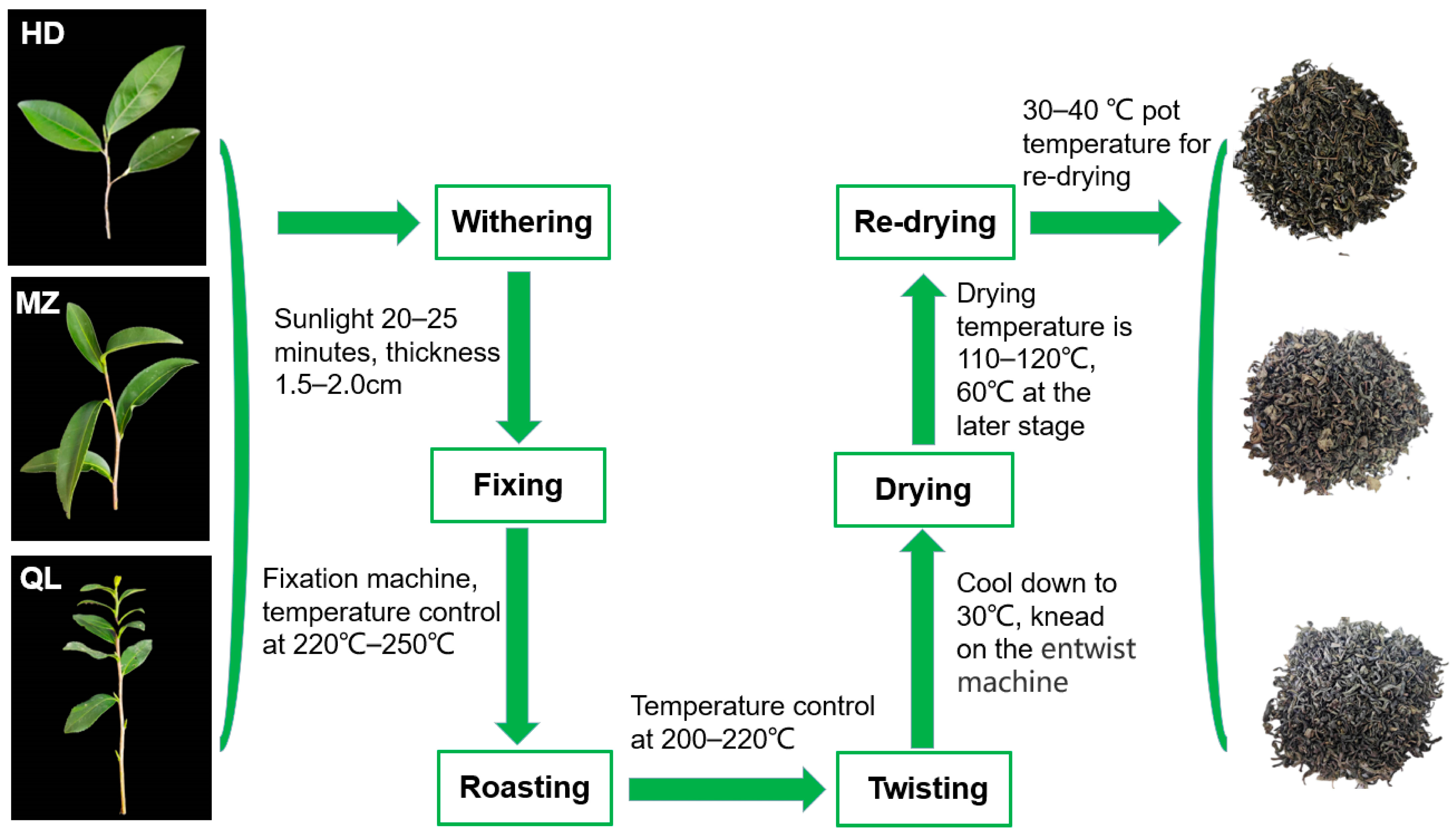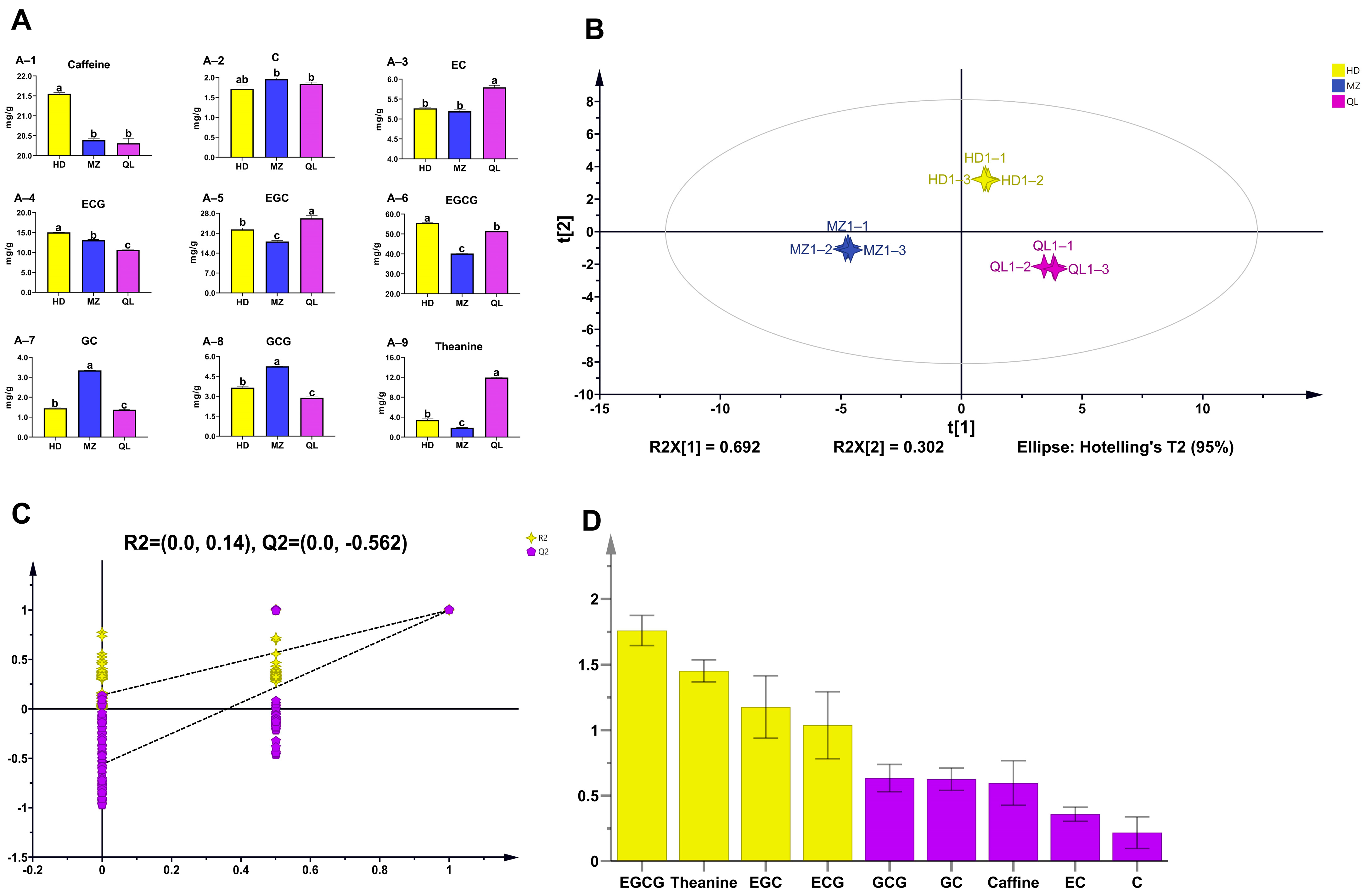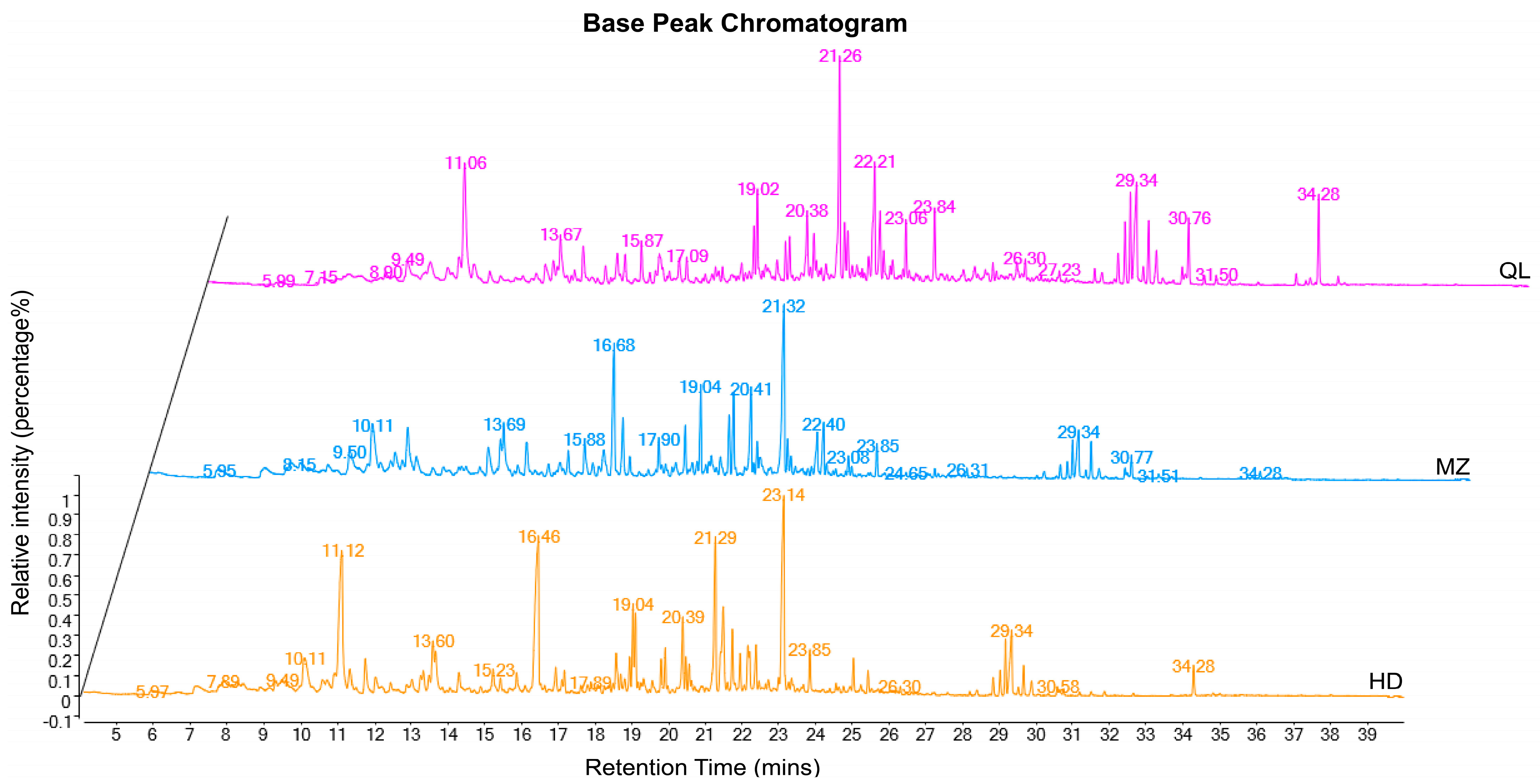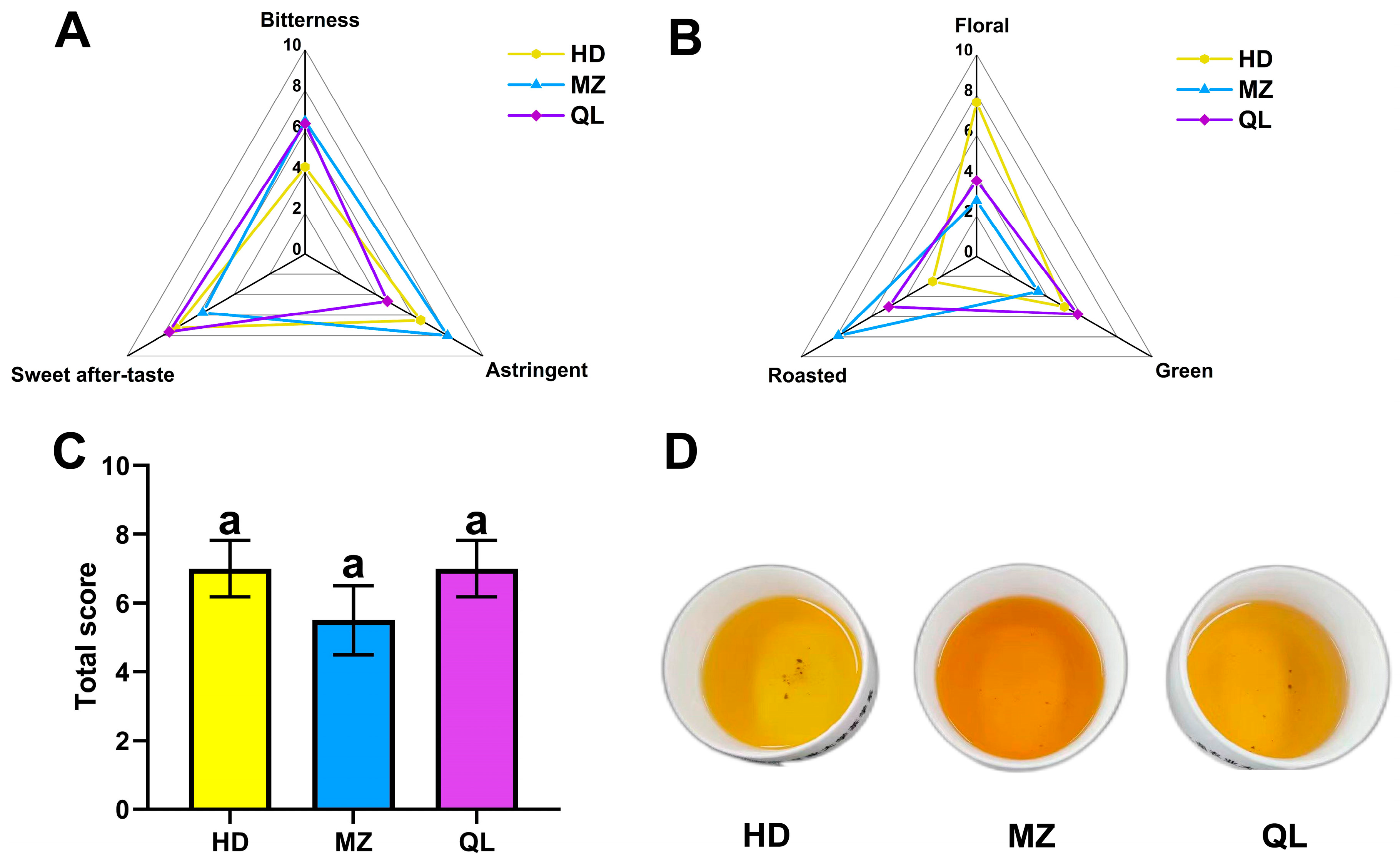The Cultivar Effect on the Taste and Aroma Substances of Hakka Stir-Fried Green Tea from Guangdong
Abstract
:1. Introduction
2. Materials and Methods
2.1. Samples
2.2. Chemicals
2.3. Analysis of Caffeine, Theanine and Catechins
2.4. GC-MS Analysis of Volatile Compounds
2.5. Calculation of Odor Activity Values (OAVs)
2.6. Sensory Evaluation
2.7. Statistical Analysis
3. Results
3.1. Quantification of Caffeine, Catechins, and Theanine in HSGTs
3.2. Volatile Components of HSGT
3.2.1. Identification and Analysis of Volatiles
3.2.2. Identification and Analysis of the Characteristic Aromas of HSGT
3.3. Sensory Qualities of the HSGTs
3.4. Correlation Analysis of the Taste and Aroma Characteristics of HSGT with the Sensory Evaluation Results
4. Discussion
4.1. EGCG, Theanine, EGC, and ECG Formed the Characteristic Tastes of the HSGTs
4.2. Geranylacetone, β-Ionone, Indole, Nerolidol, and Dihydrolinalool Formed the Characteristic Aromas of HSGTs
5. Conclusions
Supplementary Materials
Author Contributions
Funding
Data Availability Statement
Acknowledgments
Conflicts of Interest
References
- Pastoriza, S.; Pérez-Burillo, S.; Rufián-Henares, J.Á. How brewing parameters affect the healthy profile of tea. Curr. Opin. Food Sci. 2017, 14, 7–12. [Google Scholar] [CrossRef]
- Chen, S.; Liu, H.; Zhao, X.; Li, X.; Shan, W.; Wang, X.; Wang, S.; Yu, W.; Yang, Z.; Yu, X. Non-targeted metabolomics analysis reveals dynamic changes of volatile and non-volatile metabolites during oolong tea manufacture. Food Res. Int. 2020, 128, 108778. [Google Scholar] [CrossRef] [PubMed]
- Wang, J.; Li, X.; Wu, Y.; Qu, F.; Liu, L.; Wang, B.; Wang, P.; Zhang, X. HS-SPME/GC-MS reveals the season effects on volatile compounds of green tea in high-latitude region. Foods 2022, 11, 3016. [Google Scholar] [CrossRef]
- Zhang, X.; Huang, H.; Sun, S.; Li, D.; Sun, L.; Li, Q.; Chen, R.; Lai, X.; Zhang, Z.; Zheng, X.; et al. Induction of apoptosis via inactivating PI3K/AKT pathway in colorectal cancer cells using aged Chinese Hakka stir-fried green tea extract. Molecules 2022, 27, 8272. [Google Scholar] [CrossRef]
- Tong, L.; Jie, L.; Xiao, Z.; Si, H.; Yi, C.; Miao, G.; Zheng, Q.; Hong, W.; Guo, C. Discussion on improving the traditional Hakka stir-fried green vegetables in terms of flavor and appearance. Guangdong Tea Ind. 2022, 2, 13–18. (In Chinese) [Google Scholar]
- Guo, X.; Schwab, W.; Ho, C.-T.; Song, C.; Wan, X. Characterization of the aroma profiles of oolong tea made from three tea cultivars by both GC–MS and GC-IMS. Food Chem. 2022, 376, 131933. [Google Scholar] [CrossRef]
- Deng, S.; Zhang, G.; Olayemi Aluko, O.; Mo, Z.; Mao, J.; Zhang, H.; Liu, X.; Ma, M.; Wang, Q.; Liu, H. Bitter and astringent substances in green tea: Composition, human perception mechanisms, evaluation methods and factors influencing their formation. Food Res. Int. 2022, 157, 111262. [Google Scholar] [CrossRef]
- Zeng, L.; Zhou, X.; Su, X.; Yang, Z. Chinese oolong tea: An aromatic beverage produced under multiple stresses. Trends Food Sci. Technol. 2020, 106, 242–253. [Google Scholar] [CrossRef]
- Wang, P.; Yu, J.; Jin, S.; Chen, S.; Yue, C.; Wang, W.; Gao, S.; Cao, H.; Zheng, Y.; Gu, M.; et al. Genetic basis of high aroma and stress tolerance in the oolong tea cultivar genome. Hortic. Res. 2021, 8, 107. [Google Scholar] [CrossRef]
- He, C.; Li, Y.; Zhou, J.; Yu, X.; Zhang, D.; Chen, Y.; Ni, D.; Yu, Z. Study on the suitability of tea cultivars for processing oolong tea from the perspective of aroma based on olfactory sensory, electronic nose, and GC-MS data correlation analysis. Foods 2022, 11, 2880. [Google Scholar] [CrossRef]
- Cai, H.; Cheng, R.; Jin, Y.; Ding, S.; Chen, Z. Evaluation of oolong teas using 1H and 13C solid-state NMR, sensory analysis, and multivariate statistics. J. Chin. Chem. Soc. 2016, 63, 792–799. [Google Scholar] [CrossRef]
- Guo, Y.; Lai, L. Analysis on quality indicators of taste and infusion color and discrimination of famous and superior green tea with different appearances in Fujian province, PR China. J. Food Process. Preserv. 2016, 40, 1084–1092. [Google Scholar] [CrossRef]
- Krahe, J.; Krahe, M.A. Optimizing the quality and commercial value of gyokuro-styled green tea grown in Australia. Beverages 2022, 8, 22. [Google Scholar] [CrossRef]
- Huang, X.; Tang, Q.; Chen, C.; Li, Q.; Lin, H.; Bai, S.; Zhao, J.; Li, J.; Wang, K.; Zhu, M. Combined analysis of transcriptome and metabolome provides insights into nano-selenium foliar applications to improve summer tea quality (Camellia sinensis). LWT 2023, 175, 114496. [Google Scholar] [CrossRef]
- Jiang, Z.; Zhang, H.; Han, Z.; Zhai, X.; Qin, C.; Wen, M.; Lai, G.; Ho, C.-T.; Zhang, L.; Wan, X. Study on in vitro preparation and taste properties of N-Ethyl-2-Pyrrolidinone-Substituted Flavan-3-Ols. J. Agric. Food Chem. 2022, 70, 3832–3841. [Google Scholar] [CrossRef]
- Zhang, L.; Cao, Q.-Q.; Granato, D.; Xu, Y.-Q.; Ho, C.-T. Association between chemistry and taste of tea: A review. Trends Food Sci. Technol. 2020, 101, 139–149. [Google Scholar] [CrossRef]
- Zhou, C.; Tian, C.; Zhu, C.; Lai, Z.; Lin, Y.; Guo, Y.; Zhou, C.; Tian, C.; Zhu, C.; Lai, Z.; et al. Hidden players in the regulation of secondary metabolism in tea plant: Focus on non-coding RNAs. Beverage Plant Res. 2022, 2, 1–12. [Google Scholar] [CrossRef]
- Ning, J.; Li, D.; Luo, X.; Ding, D.; Song, Y.; Zhang, Z.; Wan, X. Stepwise identification of six tea (Camellia sinensis (L.)) categories based on catechins, caffeine, and theanine contents combined with fisher discriminant analysis. Food Anal. Methods 2016, 9, 3242–3250. [Google Scholar] [CrossRef]
- Ma, W.; Zhu, Y.; Ma, S.; Shi, J.; Yan, H.; Lin, Z.; Lv, H. Aroma Characterisation of Liu-Pao tea based on volatile fingerprint and aroma wheel using SBSE-GC–MS. Food Chem. 2023, 414, 135739. [Google Scholar] [CrossRef]
- Yan, T.; Lin, J.; Zhu, J.; Ye, N.; Huang, J.; Wang, P.; Jin, S.; Zheng, D.; Yang, J. Aroma analysis of Fuyun 6 and Jinguanyin black tea in the Fu’an area based on E-Nose and GC–MS. Eur. Food Res. Technol. 2022, 248, 947–961. [Google Scholar] [CrossRef]
- Ma, L.; Gao, M.; Zhang, L.; Qiao, Y.; Li, J.; Du, L.; Zhang, H.; Wang, H. Characterization of the Key aroma-active compounds in high-grade Dianhong tea using GC-MS and GC-O combined with sensory-directed flavor analysis. Food Chem. 2022, 378, 132058. [Google Scholar] [CrossRef]
- Li, M.; Zhan, P.; Wang, P.; Tian, H.; Geng, J.; Wang, L. Characterization of aroma-active compounds changes of Xiecun Huangjius with different aging years based on odor activity values and multivariate analysis. Food Chem. 2023, 405, 134809. [Google Scholar] [CrossRef] [PubMed]
- Liu, P.-P.; Feng, L.; Xu, Y.-Q.; Zheng, L.; Yin, P.; Ye, F.; Gui, A.-H.; Wang, S.-P.; Wang, X.-P.; Teng, J.; et al. Characterization of stale odor in green tea formed during storage: Unraveling improvements arising from reprocessing by baking. LWT 2023, 174, 114458. [Google Scholar] [CrossRef]
- Zhang, Y.-Y.; Zhang, P.; Le, M.-M.; Qi, Y.; Yang, Z.; Hu, F.-L.; Ling, T.-J.; Bao, G.-H. Improving flavor of summer Keemun black tea by solid-state fermentation using Cordyceps militaris revealed by LC/MS-based metabolomics and GC/MS analysis. Food Chem. 2023, 407, 135172. [Google Scholar] [CrossRef] [PubMed]
- Niu, Y.; Zhang, Y.; Xiao, Z.; Zhu, J.; Zhang, F.; Chen, F. Release effect of aroma compounds of Keemun black tea brewed with deuterium-depleted water with different deuterium content. LWT 2023, 173, 114382. [Google Scholar] [CrossRef]
- Yao, H.; Su, H.; Ma, J.; Zheng, J.; He, W.; Wu, C.; Hou, Z.; Zhao, R.; Zhou, Q. Widely targeted Volatileomics analysis reveals the typical aroma formation of Xinyang black tea during fermentation. Food Res. Int. 2023, 164, 112387. [Google Scholar] [CrossRef]
- Xu, K.; Tian, C.; Zhou, C.; Zhu, C.; Weng, J.; Sun, Y.; Lin, Y.; Lai, Z.; Guo, Y. Non-targeted metabolomics analysis revealed the characteristic non-volatile and volatile metabolites in the Rougui Wuyi rock tea (Camellia sinensis) from different culturing regions. Foods 2022, 11, 1694. [Google Scholar] [CrossRef]
- Wang, Q.; Qin, D.; Huang, G.; Jiang, X.; Fang, K.; Wang, Q.; Ni, E.; Li, B.; Pan, C.; Li, H.; et al. Identification and characterization of the key volatile flavor compounds in black teas from distinct regions worldwide. J. Food Sci. 2022, 87, 3433–3446. [Google Scholar] [CrossRef]
- Chen, Y.; Zhou, B.; Li, J.; Tang, H.; Zeng, L.; Chen, Q.; Cui, Y.; Liu, J.; Tang, J. Effects of long-term non-pruning on main quality constituents in ‘Dancong’ tea (Camellia sinensis) leaves based on proteomics and metabolomics analysis. Foods 2021, 10, 2649. [Google Scholar] [CrossRef]
- Mei, S.; Yu, Z.; Chen, J.; Zheng, P.; Sun, B.; Guo, J.; Liu, S. The physiology of postharvest tea (Camellia sinensis) leaves, according to metabolic phenotypes and gene expression analysis. Molecules 2022, 27, 1708. [Google Scholar] [CrossRef]
- Chen, P.; Cai, J.; Zheng, P.; Yuan, Y.; Tsewang, W.; Chen, Y.; Xiao, X.; Liao, J.; Sun, B.; Liu, S. Quantitatively unravelling the impact of high altitude on oolong tea flavor from Camellia sinensis grown on the plateaus of Tibet. Horticulturae 2022, 8, 539. [Google Scholar] [CrossRef]
- Liu, Z.; Liu, L.-X.; Han, Q.-D.; Dong, G.-Z.; Wang, B.; Zhang, J.-F.; Lei, S.-M.; Liu, Y.-G. Quality assessment of rose tea with different drying methods based on physicochemical properties, HS–SPME–GC–MS, and GC–IMS. J. Food Sci. 2023, 88, 1378–1391. [Google Scholar] [CrossRef] [PubMed]
- Yu, X.; Sun, D.; He, Y. Emerging techniques for determining the quality and safety of tea products: A review. Compr. Rev. Food Sci. Food Saf. 2020, 19, 2613–2638. [Google Scholar] [CrossRef] [PubMed]
- Zeng, L.; Fu, Y.-Q.; Liu, Y.-Y.; Huang, J.-S.; Chen, J.-X.; Yin, J.-F.; Jin, S.; Sun, W.-J.; Xu, Y.-Q. Comparative analysis of different grades of Tieguanyin oolong tea based on metabolomics and sensory evaluation. LWT 2023, 174, 114423. [Google Scholar] [CrossRef]
- Fu, J.; Yu, H.-D.; Wu, L.; Zhang, C.; Yun, Y.-H.; Zhang, W. Authentication of geographical origin in Hainan partridge tea (Mallotus obongifolius) by stable isotope and targeted metabolomics combined with chemometrics. Foods 2021, 10, 2130. [Google Scholar] [CrossRef] [PubMed]
- Gao, C.; Huang, Y.; Li, J.; Lyu, S.; Wang, Z.; Xie, F.; Luo, Y.; Zhang, F.; Chen, Z.; Sun, W. Relationship between the grade and the characteristic flavor of PCT (Panyong Congou black tea). Foods 2022, 11, 2815. [Google Scholar] [CrossRef]
- Li, M.; Guo, L.; Zhu, R.; Yang, D.; Xiao, Y.; Wu, Y.; Zhong, K.; Huang, Y.; Gao, H. Effect of fixation methods on biochemical characteristics of green teas and their lipid-lowering effects in a zebrafish larvae model. Foods 2022, 11, 1582. [Google Scholar] [CrossRef]
- Guo, X.; Ho, C.-T.; Wan, X.; Zhu, H.; Liu, Q.; Wen, Z. Changes of volatile compounds and odor profiles in Wuyi rock tea during processing. Food Chem. 2021, 341, 128230. [Google Scholar] [CrossRef]
- Guo, X.; Ho, C.-T.; Schwab, W.; Wan, X. Aroma profiles of green tea made with fresh tea leaves plucked in summer. Food Chem. 2021, 363, 130328. [Google Scholar] [CrossRef]
- Qiao, Z.; Yong, Z.; Li, G.; Shu, L.; Xiu, L.; Jia, Z.; Ying, Z.; Cai, L. Dynamic changes of quality components in Hakka roasted green tea during processing. Mod. Food Sci. Technol. 2022, 38, 248–256. (In Chinese) [Google Scholar] [CrossRef]
- Ren, G.; Zhang, X.; Wu, R.; Yin, L.; Hu, W.; Zhang, Z. Rapid characterization of black tea taste quality using miniature NIR spectroscopy and electronic tongue sensors. Biosensors 2023, 13, 92. [Google Scholar] [CrossRef]
- Wang, B.; Qu, F.; Wang, P.; Zhao, L.; Wang, Z.; Han, Y.; Zhang, X. Characterization analysis of flavor compounds in green teas at different drying temperature. LWT 2022, 161, 113394. [Google Scholar] [CrossRef]
- Zhu, J.; Wang, J.; Yuan, H.; Ouyang, W.; Li, J.; Hua, J.; Jiang, Y. Effects of fermentation temperature and time on the color attributes and tea pigments of Yunnan Congou black tea. Foods 2022, 11, 1845. [Google Scholar] [CrossRef] [PubMed]
- Adhikary, B.; Kashyap, B.; Gogoi, R.C.; Sabhapondit, S.; Babu, A.; Deka, B.; Pramanik, P.; Das, B. Green Tea processing by pan-firing from region-specific tea (Camellia sinensis L.) cultivars—A novel approach to sustainable tea production in Dooars region of North Bengal. Food Chem. Adv. 2023, 2, 100181. [Google Scholar] [CrossRef]
- Chen, Y.-H.; Zhang, Y.-H.; Chen, G.-S.; Yin, J.-F.; Chen, J.-X.; Wang, F.; Xu, Y.-Q. Effects of phenolic acids and quercetin-3-O-rutinoside on the bitterness and astringency of green tea infusion. NPJ Sci. Food 2022, 6, 1–8. [Google Scholar] [CrossRef]
- Xu, Y.-Q.; Zhang, Y.-N.; Chen, J.-X.; Wang, F.; Du, Q.-Z.; Yin, J.-F. Quantitative analyses of the bitterness and astringency of catechins from green tea. Food Chem. 2018, 258, 16–24. [Google Scholar] [CrossRef]
- Zhao, S.; Cheng, H.; Xu, P.; Wang, Y. Regulation of biosynthesis of the main flavor-contributing metabolites in tea plant (Camellia sinensis): A review. Crit. Rev. Food Sci. Nutr. 2022, 1–16. [Google Scholar] [CrossRef]
- Wang, J.; Zhang, Y.; Liu, Y.; Zhang, S.; Yuan, L.; Zhong, Y.; Wu, X.; Yang, J.; Xu, Z. Multi-metabolomics coupled with quantitative descriptive analysis revealed key alterations in phytochemical composition and sensory qualities of decaffeinated green and black tea from the same fresh leaves. Foods 2022, 11, 3269. [Google Scholar] [CrossRef]
- Jiang, H.; Zhang, M.; Wang, D.; Yu, F.; Zhang, N.; Song, C.; Granato, D. Analytical strategy coupled to chemometrics to differentiate Camellia sinensis tea types based on phenolic composition, alkaloids, and amino acids. J. Food Sci. 2020, 85, 3253–3263. [Google Scholar] [CrossRef]
- Gong, A.-D.; Lian, S.-B.; Wu, N.-N.; Zhou, Y.-J.; Zhao, S.-Q.; Zhang, L.-M.; Cheng, L.; Yuan, H.-Y. Integrated transcriptomics and metabolomics analysis of catechins, caffeine and theanine biosynthesis in tea plant (Camellia sinensis) over the course of seasons. BMC Plant Biol. 2020, 20, 294. [Google Scholar] [CrossRef]
- Wang, Z.; Gan, S.; Sun, W.; Chen, Z. Quality characteristics of oolong tea products in different regions and the contribution of thirteen phytochemical components to its taste. Horticulturae 2022, 8, 278. [Google Scholar] [CrossRef]
- Li, Y.; Ran, W.; He, C.; Zhou, J.; Chen, Y.; Yu, Z.; Ni, D. Effects of different tea tree varieties on the color, aroma, and taste of Chinese Enshi green tea. Food Chem. X 2022, 14, 100289. [Google Scholar] [CrossRef]
- Fang, Q.-T.; Luo, W.-W.; Zheng, Y.-N.; Ye, Y.; Hu, M.-J.; Zheng, X.-Q.; Lu, J.-L.; Liang, Y.-R.; Ye, J.-H. Identification of key aroma compounds responsible for the floral ascents of green and black teas from different tea cultivars. Molecules 2022, 27, 2809. [Google Scholar] [CrossRef] [PubMed]
- Zeng, L.; Jin, S.; Xu, Y.-Q.; Granato, D.; Fu, Y.-Q.; Sun, W.-J.; Yin, J.-F.; Xu, Y.-Q. Exogenous stimulation-induced biosynthesis of volatile compounds: Aroma formation of oolong tea at postharvest stage. Crit. Rev. Food Sci. Nutr. 2022, 1–11, AHEAD-OF-PRINT. [Google Scholar] [CrossRef]
- Ming, Z.; Dong, C.; Qiu, W.; Li, X. The study on sensory quality characteristics and influencing factors of Guangdong Hakka tea. Guangdong Agric. Sci. 2011, 38, 79–81. (In Chinese) [Google Scholar] [CrossRef]
- Deng, X.; Huang, G.; Tu, Q.; Zhou, H.; Li, Y.; Shi, H.; Wu, X.; Ren, H.; Huang, K.; He, X.; et al. Evolution analysis of flavor-active compounds during artificial fermentation of Pu-Erh tea. Food Chem. 2021, 357, 129783. [Google Scholar] [CrossRef]
- Guo, X.; Ho, C.-T.; Schwab, W.; Wan, X. Effect of the roasting degree on flavor quality of large-leaf yellow tea. Food Chem. 2021, 347, 129016. [Google Scholar] [CrossRef]
- Yin, X.; Huang, J.; Huang, J.; Wu, W.; Tong, T.; Liu, S.; Zhou, L.; Liu, Z.; Zhang, S. Identification of volatile and odor-active compounds in Hunan black tea by SPME/GC-MS and multivariate analysis. LWT 2022, 164, 113656. [Google Scholar] [CrossRef]
- Qu, F.; Li, X.; Wang, P.; Han, Y.; Wu, Y.; Hu, J.; Zhang, X. Effect of thermal process on the key aroma components of green tea with chestnut-like aroma. J. Sci. Food Agric. 2023, 103, 657–665. [Google Scholar] [CrossRef]
- Yin, P.; Wang, J.-J.; Kong, Y.-S.; Zhu, Y.; Zhang, J.-W.; Liu, H.; Wang, X.; Guo, G.-Y.; Wang, G.-M.; Liu, Z.-H. Dynamic changes of volatile compounds during the Xinyang Maojian green tea manufacturing at an industrial scale. Foods 2022, 11, 2682. [Google Scholar] [CrossRef]






| Var. No. | Volatile Compounds | Odor Type | VIP | OT 1 (µg/L) | OAV | ||
|---|---|---|---|---|---|---|---|
| HD | MZ | QL | |||||
| Var_21 | β-Ionone | Floral | 3.04 | 8.4 a | 0.00 | 72.59 | 26.48 |
| Var_57 | Indole | Floral | 2.50 | 40 a | 10.11 | 3.10 | 1.24 |
| Var_4 | Nerolidol | Floral | 2.49 | 250 a | 1.39 | 0.00 | 0.00 |
| Var_2 | Dihydrolinalool | Woody | 2.02 | 70 c | 6.34 | 3.56 | 3.01 |
| Var_17 | Geranylacetone | Floral | 1.91 | 0.06 b | 1841.00 | 4402.83 | 1211.00 |
| Var_40 | Methyl salicylate | Green | 1.48 | 40 a | 1.91 | 2.92 | 0.27 |
| Var_50 | 1,2-Dihydro-1,1,6-trimethylnaphthalene | Woody | 1.22 | 2.5 a | 6.67 | 36.68 | 5.69 |
| Var_16 | Jasmone | Floral | 1.18 | 7 a | 12.31 | 0.00 | 1.78 |
| Var_13 | β-Cyclocitral | Woody | 1.14 | 3 a | 19.94 | 37.24 | 14.27 |
| Var_22 | D-Limonene | Fruity | 1.01 | 34 a | 0.85 | 2.27 | 0.71 |
Disclaimer/Publisher’s Note: The statements, opinions and data contained in all publications are solely those of the individual author(s) and contributor(s) and not of MDPI and/or the editor(s). MDPI and/or the editor(s) disclaim responsibility for any injury to people or property resulting from any ideas, methods, instructions or products referred to in the content. |
© 2023 by the authors. Licensee MDPI, Basel, Switzerland. This article is an open access article distributed under the terms and conditions of the Creative Commons Attribution (CC BY) license (https://creativecommons.org/licenses/by/4.0/).
Share and Cite
Qiu, Z.; Liao, J.; Chen, J.; Chen, P.; Sun, B.; Li, A.; Pan, Y.; Liu, H.; Zheng, P.; Liu, S. The Cultivar Effect on the Taste and Aroma Substances of Hakka Stir-Fried Green Tea from Guangdong. Foods 2023, 12, 2067. https://doi.org/10.3390/foods12102067
Qiu Z, Liao J, Chen J, Chen P, Sun B, Li A, Pan Y, Liu H, Zheng P, Liu S. The Cultivar Effect on the Taste and Aroma Substances of Hakka Stir-Fried Green Tea from Guangdong. Foods. 2023; 12(10):2067. https://doi.org/10.3390/foods12102067
Chicago/Turabian StyleQiu, Zihao, Jinmei Liao, Jiahao Chen, Peifen Chen, Binmei Sun, Ansheng Li, Yiyu Pan, Hongmei Liu, Peng Zheng, and Shaoqun Liu. 2023. "The Cultivar Effect on the Taste and Aroma Substances of Hakka Stir-Fried Green Tea from Guangdong" Foods 12, no. 10: 2067. https://doi.org/10.3390/foods12102067
APA StyleQiu, Z., Liao, J., Chen, J., Chen, P., Sun, B., Li, A., Pan, Y., Liu, H., Zheng, P., & Liu, S. (2023). The Cultivar Effect on the Taste and Aroma Substances of Hakka Stir-Fried Green Tea from Guangdong. Foods, 12(10), 2067. https://doi.org/10.3390/foods12102067





